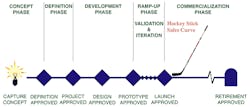Do Your New Products Sell Like Hockey Sticks?
The blade is often avoidable, but not always. If your company’s products must get “spec’d-in” to a customer’s final assembly, flat initial sales may be expected as the customer assimilates the product into theirs. This is often the case in the automotive, aerospace, semiconductor, and other heavily tiered industries. Only when the customer’s model is released do your pull-through sales start rising up the handle. Flat sales may also be expected in municipal, government, and capital-intensive industries awaiting the next fiscal year budget or capital approval cycle. When the next year’s plan is approved, your sales begin.
Blades are also expected when products are new-to-the-world or too innovative for their value to be immediately recognized. It takes a while for the marketplace to warm up to your offering and, hence, sales are flat. Geoffrey Moore’s 1991 book, Crossing the Chasm, addressed this “chasm” of no sales while the marketplace assessed a new product’s value equation.
The most difficult situation to fix is when a company has a poor reputation for new products. It is often described as, “Company X always releases products prematurely and they are unreliable. Wait a year until they get the bugs out and then buy it.” Causes for this reputation include aggressive sales organization pull, management-imposed launch dates, and poor product testing. All these scenarios require systematic fixes and often culture changes as well.
Another hard situation to fix is actually caused by product development. Product development teams are usually late to market. Sales has learned this and adjusts accordingly. They don’t get customers excited early because they know they might have to ask them to wait on a delay. So Sales waits until they have the product in their hands.
More often than not, simple tweaks to the product development process (PDP) will transform it into a “product commercialization process.” Many PDPs are designed to optimize development, not commercialization. So new products get thrown over the wall to sales.
Developing pieces for trade publications and advertising, sales-force training, scheduling customer visits, customer assimilation time, and other launch necessities all take time. True product commercialization processes overlap many of these activities with testing and ramp-up activities that precede launch.
Thinking agile, are there tasks that are usually all done at the end of development that could be broken down into batches that start earlier? We have at least a decade of experience using this approach in development. Let’s take this thinking and apply it to commercialization.
Hockey-stick sales reduce developer satisfaction as market acceptance is delayed. They also slow down company sales and profits while giving customers pause for thought as they wait for others to take the plunge. The best business hockey stick has no blade, only a handle.
About the Author
Bradford Goldense
Contributing Technical Expert
Bradford L. Goldense is founder and president of Goldense Group, Inc. [GGI] (www.goldensegroupinc.com), a consulting, market research, and education firm focused on business and technology management strategies and practices for product creation, development, and commercialization. He has been an adjunct faculty member of the graduate engineering school at Tufts University's Gordon Institute for 19 years. Goldense is a Certified New Product Development Professional [NPDP], a Certified Manufacturing Engineer [CMfgE], a Certified Computer Professional [CCP], and is Certified In Production & Inventory Management [CPIM]. He holds over 200 registered copyrights and is a recognized subject-matter expert, including appearances on PBS and CNBC. He has consulted to over 250 companies and over 750 manufacturing locations on four continents since founding GGI in 1986. Goldense holds an MBA in Accounting from the Cornell Johnson School and a BSCE from Brown University. For more information, please see Brad's LinkedIn profile or visit GGI's home page.


